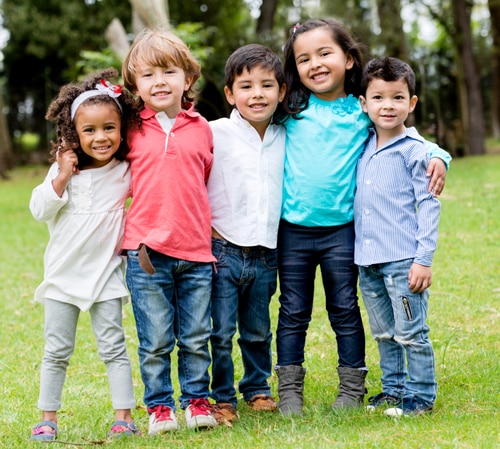How to Teach Your Children to Feel Empathy
One of the most important things we can do as parents is raise our kids to be compassionate little humans. Teaching them to understand and be to sensitive to the feelings of others means they (hopefully) won’t grow up to be selfish jerks. We often think of empathy as an innate trait – you’ve either got it, or you don’t. It’s not that simple, though. Children develop empathy through experiences and modeled behavior. Teaching empathy starts with us, and there are ways we can guide our kids toward being thoughtful, kind, empathetic little people.
Teaching empathy takes time, and it requires us to put on our “kid-thinking caps.”
The fact is, kid brains are still a jumble of a lot of different feelings, wants, and needs. The way they process these feelings and wants and needs is markedly different from adults. Telling a 5-year-old to “imagine yourself in someone’s shoes” will likely end in that kid literally picturing themselves wearing someone else’s actual shoes! But before we try and teach our children empathy, it helps to understand what empathy means.
Emotional sharing, empathic concern, and perspective-taking are three distinct processes that are under the “empathy” umbrella.
Emotional sharing is when we share in the emotions we observe in other people (I can’t be the only person who cries when I see someone else cry, right?). Empathic concern is our ability to care for others who are vulnerable or in distress, like wanting to adopt all the kids in those world hunger commercials. Perspective-taking means putting yourself in someone else’s shoes, and imagining what that person is thinking or feeling.
But how do we translate this so it’s easy for kids to understand and model? Especially younger children, who lack the cognitive skills to really understand the concept of empathy? There are definitely some age-appropriate things we, as parents, can do.
- Help your kids label their feelings. Kids have the same emotions as we do, and often on a much grander scale. Kids can run the gamut of emotions in a five-minute span. And they often can’t full express the “feeling” they’re feeling. So help them by giving those feelings a name. Sadness, fear, excitement, loneliness – when your kids are experiencing an emotion, try to help them label it, and figure out why they’re feeling the way they are.
- Encourage your kids to talk about their feelings! As adults, we do this on a fairly regular basis (at least, we should). And I know firsthand that when a kid loses their mind and goes into a fit of rage or anger or despair, your first instinct is to get through the storm and forget it after it’s over. But taking the time to talk those feelings out with your kids, paying special attention to the how and why they felt that way, can help them understand these feelings in others. Especially if you’re open and honest about YOUR OWN emotions with your children.
- Honestly, teach good old fashioned politeness! Teaching empathy can start with very simple good manners. Teach your child to say please, thank you, or excuse me on a regular basis. And not just with others outside of the home! These behaviors need to be modeled and practiced regularly, every day. I can’t even count how many times I’ve waited to do something for my own kids until I got a please or thank you. It’s just common courtesy, and teaching them to be respectful of others is so important.
- They’re never too young for charity. I started taking my oldest daughter to volunteer at charitable organizations when she was 5, and plan on continuing the same tradition with my youngest child. It’s one thing to say, “There are people and children who are not nearly as privileged as us.” It’s quite another for them to see it with their own eyes. It can be something as simple as having your child pick out toys to donate to a local shelter for families, or cutting old blankets and towels for an animal shelter. Make sure you explain why she’s donating the toys, or why shelters have animals that need our help.
Teaching empathy isn’t something you’ll be able to do in a day, or a weekend, or even a month. It’s about helping your child to understand their feelings, helping them development a connection to the world around them, and just teaching them (everyday!) to be kind, caring little humans.
{Also Read: How to Help Your Kiddos Feel Better When They’re Sick}
(Image: iStock/Lordn)





